
Official Edgar Rice Burroughs Tribute and Weekly Webzine Site
Since 1996 ~ Over 15,000 Webpages in Archive
Volume 7003
TARZAN OF THE APES
Summary and Comments by John Martin: Pt. III
Chapters 15-21
![]()

![]()
TARZAN OF THE APES, CHAPTER XV: THE FOREST GOD
"The Forest God" of this chapter is Tarzan, and the one who applies the name to him is William Clayton, who has just been rescued from a lion.In the jungle, if it isn't one thing, it's another. And while Numa is going after Clayton, one of his possible mates, Sabor the lioness, is going after Jane and Esmeralda.
The chapter begins with Tarzan and Clayton hearing the gunshot (fired by Jane) and ends with Jane "screaming with hysterical laughter" (not our typical image of Jane but, hey, we all have our moments!).
When we last left Jane, at the end of the previous chapter, she had fired a gun, wounding the lioness which was trying to crawl into the cabin through a window, in order to dine on Jane and her maid, Esmeralda.
As Chapter 15 begins, we see Tarzan and Clayton hurrying toward the sound of the gunfire, as they don't know who fired the shot, or why.
Clayton can't move as fast as Tarzan, so Tarzan decides to carry Clayton piggy-back through the treetops. Clayton believes he is being carried along at terrifying speeds, but Tarzan is inwardly chafing at the relatively slow progress he is making with the weight of a passenger. Making the treetop ride more perilous for Clayton is the fact that it is nighttime, with the moon lighting their way only when breaks in the foliage permit. The way ERB describes it, riding on Tarzan's back through the treetops at night might be analogous to taking a trip on Disney's Space Mountain.
Meanwhile, back at the beach, the lioness had made a renewed effort to get into the cabin and was pretty much succeeding. Esmeralda had fainted. Jane picked up the gun and decided to shoot Esmeralda and herself to end their misery quickly, rather than die beneath the talons and teeth of Sabor.
Burroughs spends several agonizing paragraphs describing Jane's preparations to pull the trigger, and all the while the reader is screaming: "Jane! What's the matter with you! Don't shoot yourself and your maid! Pump a couple more bullets into that lion's face!"
But Jane can't hear us, and pulls the trigger on Esmeralda anyway, thus proving she is capable of doing it. Fortunately, favor smiles upon her, as she is distracted by a scream from Sabor and it causes her bullet to miss her slumbering employee.
What caused Sabor to scream is that Tarzan had arrived and, if you read the original version of this story, had "a tiger by the tail," hauling Sabor back out of the window.
All the while he hauls, Tarzan is jabbering in ape talk to Clayton, telling him to grab some of the poison arrows from Tarzan's quiver or to grab the knife and stab Sabor before she gets all the way out of the cabin. Clayton can't understand a word and also can't figure this out for himself. Tarzan can't let loose of Sabor in order to do it himself, so he resorts to pulling her out and then quickly falling on her back and executing the full-Nelson he learned in his earlier battle with Terkoz.
Sabor's neck is soon cracked. Tarzan departs the area immediately, leaving Clayton to tell the good news to Jane and an awakening Esmeralda, thus triggering Jane's spasm of relieved, crazy laughter.
- - - - -
TARZAN TREE TRAVEL:
From one lofty branch the agile creature swung with Clayton through a dizzy arc to a neighboring tree; then for a hundred yards maybe the sure feet threaded a maze of interwoven limbs, balancing like a tightrope walker high above the black depths of verdure beneath.
TARZAN OF THE APES, CHAPTER XVI: "MOST REMARKABLE"
After all of the blood-churning episodes experienced so far in this novel by Tarzan's parents, Tarzan himself, and now the newly stranded party of westerners on the African beach, it's time for some comic relief as we pause to catch our breath."Most remarkable" is the phrase uttered repeatedly by Professor Archimedes Q. Porter, the father of Jane Porter. We last see him, and his colleague, Mr. Samuel T. Philander, in Chapter XIII, when they wander off into the jungle and, when they assay to return to the rest of the group, head instead toward Cape Town, 1,500 miles to the south. (So if you want to know the location of Tarzan's cabin, get out your maps of Africa and check out its mileage guide.)
Clayton goes to search for them in Chapter XIV, but needs rescuing by Tarzan. Tarzan and Clayton then rescue Jane and Esmeralda in Chapter XV. Now, it is time to learn the fate of the two elderly gentlemen.
Professor Porter, the absent-minded scholar, and the somewhat similarly distracted Mr. Philander are walking the beach alonside the potential terrors from the adjacent jungle. Their discussion centers around the legacy of European history.
Their engrossing conversation is interrupted by the appearance of a quadruped of the genus Felis, which Mr. Philander sloppily refers to by its "slang term" of "lion."
This lion, which has wandered far from its natural habitat on the Savannah, has recently fed, fortunately for them. But their hurried attempts at escape excite the cat anyway, and Tarzan has to haul them into a tree for their own good.Tarzan, with gestures, then leads them back to the main group, and all the castaways are still none-the-wiser that this primitive benefactor is the same educated person who wrote the note on the cabin door, signed by Tarzan of the Apes.
In Chapter XI, ERB mentions that Sheeta, alone, of all animals will torture its prey, but that other animals provide a quick and merciful death to their victims. But that doesn't mean that the predators don't have a little "fun" while they're inflicting those quick and merciless deaths, for ERB tells us "...the one great danger was that one of the men might stumble and fall, and then the yellow devil would be upon him in a moment and the joy of the kill would be too great a temptation to withstand."
We learn in this chapter that Jane Porter's late mother was also named Jane.
- - - - - POP QUIZ:
Porter and Philander have known each other since childhood, and they have nicknames by which they sometimes address each other.
How does Professor Porter sometimes refer to Mr. Philander?
What does Mr. Philander sometimes call Professor Porter?
Professor Porter is well known for his saying of "Most remarkable," probably because that is the name ERB chose for this chapter. But...
When the professor saw the lion, which he presumed had escaped from a zoo, his reaction was to say: "Most R_________." What "R" word did the professor use?
What other two-word phrase is repeatedly on Professor Porter's lips, far more often than "Most Remarkable"?.
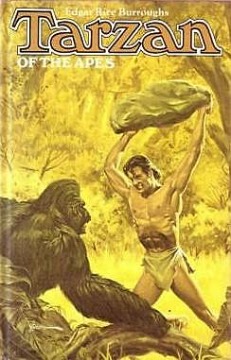
1. Al Anderson was the artist for this cover on a 1966 Whitman edition of "Tarzan of the Apes.
2. George Gross provided the illustration for the cover of this 1973 Grosset & Dunlap reprint of "Tarzan of the Apes."
TARZAN OF THE APES, CHAPTER XVII: BURIALS
The events in this chapter take place in less than a day, beginning with sunrise, when the castaways arise and dine on provisions left them by the mutineers, and ending with Jane snuffing the lamp in the cabin, and Tarzan stuffing her letter in his quiver.In between, there are four burial events.
The first burial, a formal one, comes when the castaways examine items in the cabin closely enough to determine that the skeletons belong to John and Alice Clayton, and the small skeleton to their newborn son. However, Mr. Philander examines the small skull and remarks on something about it to Professor Porter who, indeed, agrees that the subject under discussion is "Most Remarkable." Whatever it was they were talking about (we think we know), they decide not to bother mentioning it to the others. The three skeletons are buried "beside their little African cabin."
The castaways notice that the Arrow, the ship now piloted by the mutineers, is leaving the harbor, and this interests Tarzan as well, who heads to the ocean for a better look at his first sailing ship.
The ship's crew observes smoke on the horizon, betokening another ship, and decides to send a small crew ashore to bury a "great chest." This is the second burial; the mutineers end up burying not only the chest, but also their self-appointed new captain, Snipes, whom one of the other crew members dispatches with the swing of his pick.The third burial occurs after the mutineers row back to the ship. Tarzan of the Apes has been watching all of this and, although he doesn't understand what is going on, he follows the maxim of "ape see, ape do," and, with an abandoned shovel, digs up Snipes and the chest. Snipes is then put back in the ground and Tarzan fills the hole with dirt, thus completing the third burial.
Tarzan carries the chest and shovel a long way into the jungle to a spot he will always be able to find again—the Great Apes' Dum-Dum arena. Here he digs a hole just large enough for the chest and then accomplishes the fourth burial of this chapter.
Tarzan then returns to the cabin to once again observe the castaways.
For the first time, he sees the use of man-made light, as the castaways have gotten the old lamps in the cabin to work. They have erected a partition, so the ladies can have privacy. Tarzan doesn't waste much time watching the men, but moves to the window where he can observe the girl of his newfound dreams.
Totally unaware of the impropriety of spying on a young maiden, Tarzan watches Jane until it is time for bed. Then, we read:
She went to the bed upon which had been spread several layers of soft grasses. These she rearranged.Then she loosed the soft mass of golden hair which crowned her head. Like a shimmering waterfall turned to burnished metal by a dying sun it fell about her oval face; in waving lines, below her waist it tumbled. (Jane had very long hair!)
ERB tells us "Tarzan was spellbound," and so is the voyeuristic reader, wondering just how far ERB is going to go with this. But, Victorian principles are upheld, and "she extinguished the lamp," leaving Tarzan to ponder the "Cimmerian darkness."
- - - - - POP QUIZ:
Professor Porter is known for repeatedly uttering "Most Remarkable" and one other two-word expression. What is Mr. Philander's favorite two-word expletive in this and the previous chapter?- - - - - FIRST-SUCH:
For the first time in the Tarzan series, we see the ape-man utilizing his quiver for something other than just carrying arrows. After Jane goes to bed, Tarzan—fascinated by the fact she has been writing something-- reaches through the window to swipe the letter and, folding it, places it in his quiver.- - - - - TARZAN THE CIMMERIAN:
Before Robert E. Howard first penned the adventures of Conan of Cimmeria, ERB had already used the word in a published work of fiction. The word, of course, was an ancient word, and available to both writers. It originally referred to one of a mythical people described by Homer as inhabiting a land of perpetual darkness—thus, ERB 's reference in this chapter to "Cimmerian darkness."- - - - - READING TARZAN BOOKS:
Back in Chapter 7, "The Light of Knowledge," Burroughs said Tarzan's attention "was soon riveted by the books which seemed to exert a strange and powerful influence over him, so that he could scarce attend to aught else." I observed then that Burroughs was, unknowingly, writing about the strange and powerful influence his own books would have over the uncounted many, over the years, who would read them.Here, in this chapter, ERB makes another reference to books that struck me as unintentionally prophetic. As Tarzan looks into the cabin, he sees the two older men engaged in discussion while the younger man (Clayton) "...tilted back against the wall on an improvised stool, was deeply engrossed in reading one of Tarzan's books." How often have we, too, been "deeply engrossed in reading one of Tarzan's books"?
- - - - - TARZAN'S STRENGTH:
Tarzan's acquisition of the great chest showed he was pretty darn strong. "Four sailors had sweated beneath the burden of its weight—Tarzan of the Apes picked it up as though it had been an empty packing case, and with the spade slung to his back by a piece of rope, carried it off into the densest part of the jungle."- - - - - SPECIAL PASSAGE:
From the trees Tarzan of the Apes watched the solemn ceremony; but most of all he watched the sweet face and graceful figure of Jane Porter.In his savage, untutored breast new emotions were stirring. He could not fathom them. He wondered why he felt so great an interest in these people—why he had gone to such pains to save the three men. But he did not wonder why he had torn Sabor from the tender flesh of the strange girl.
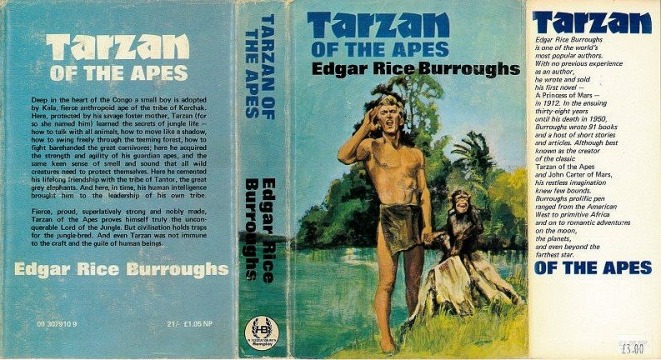
.
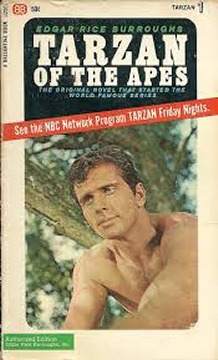
1. Over the years, editions of "Tarzan of the Apes" have sometimes featured images of those who have played Tarzan in the movies.
This one features Denny Miller and was published by Howard Baker of England.
2. Over the years, editions of "Tarzan of the Apes" have sometimes featured images of those who have played Tarzan in the movies.
This trade paperback features a typical scene from a Johnny Weissmuller movie and
was published a year ago by Edgar Rice Burroughs, Inc.
3. Over the years, editions of "Tarzan of the Apes" have sometimes featured images of those who have played Tarzan in the movies.
This Ballantine paperback features a photo of late 60s TV Tarzan Ron Ely.
A different Ely photo is on a Ballantine edition of "The Return of Tarzan."
TARZAN OF THE APES, CHAPTER XVIII: THE JUNGLE TOLL
Tarzan has stolen Jane's letter and, by the end of the chapter, a "gorilephant" has stolen Jane.Tarzan stole the letter at night, at the end of the last chapter. And, with the break of dawn, he plucks it from his quiver to enjoy a good read, his simple mind not aware of the scandal of reading someone else's mail, but only absorbed with the fact that the letter "was an expression of her thoughts and that was all sufficient."
Jane wrote the letter to her friend, Hazel. It serves as a literary device to bring us up to date on the events which brought Jane and her group to the position of being castaways. We are told of Professor Porter's successful treasure hunt, which then turned unsuccessful because of the greedy sailors who stole the treasure and abandoned them. We also learn of one Robert Canler, who financed the expedition, and of his possible claims on the hand of Jane.
Tarzan has some difficulty figuring out how to read Jane's letter because not only is it in cursive, but it's also sloped the opposite way of other hand-writing Tarzan has seen (Question: Is Jane left-handed?).
The letter tells us that Tarzan's little cabin is located on the West Coast of Africa, about 10 degrees south latitude.
We learn of Tarzan's timidity. Though he was bold to confront Sabor and Numa, and apes four times his size, and risked visits to Mbonga's cannibal village again and again, Tarzan has the natural timidity of the wild beast and is cautious about revealing himself fully to the castaways occupying his cabin. However, his attraction to Jane is so strong that he eventually works up the willpower to do it.
First, he wrote "I am Tarzan of the Apes" on the bottom of Jane's letter and put it back in the cabin, figuring this would clear up the misunderstanding, expressed in the letter, that the castaway's benefactor and Tarzan of the Apes were two different people. When Jane finds the letter, she is horrified to think that this Tarzan may have been watching her through the window.
Tarzan then writes a note, declaring his love for Jane, and telling her "You are mine." He promises to take care of her and hunt for her and protect her as they dwell in his cabin together.
Tarzan goes to the cabin, but no one is home. Like his parents long ago, they have grown lax about venturing far from the cabin, and are off in different directions, foraging for food.
A scream alerts everyone. The other castaways find a gibbering Esmeralda who can only relate, through her hysteria, that Jane has been carried off by a black, hairy thing which she describes as a gorilephant.
Tarzan is alerted, too, and "shot like a panther into the forest." We don't read of Tarzan again in this chapter but we instinctively know that whatever he is doing will be of far greater value than whatever the castaways do.
After fruitless efforts to locate Jane, the castaways return to the cabin for a night of unsettling rest. Professor Porter is no longer the distracted one, but is focused on the plight of his daughter. He vows to go into the forest to find her, and to not return until he does, effectively sentencing himself to death. Clayton is determined to accompany him and, for the first time, the professor sees in Clayton's face the love he has for Jane. So, it is agreed they will go together. Mr. Philander will stay to watch over Esmeralda.
- - - - - KEY PASSAGE:
Professor Porter expresses his rationale for taking up a likely fruitless search for Jane:
"Jane is beyond human assistance now. I simply go that I may face my Maker with her, and know, too, that what was once my dear little girl lies not alone and friendless in the awful jungle.
"The same vines and leaves will cover us, the same rains beat upon us; and when the spirit of her mother is abroad, it will find us together in death, as it has always found us in life...."
.
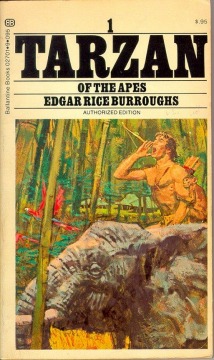
1. Full-cover Robert Abbett art on 1969 Ballantine paperback
2. White-border cover with Robert Abbett art on early 1970s Ballantine paperback
TARZAN OF THE APES, CHAPTER XIX: THE CALL OF THE PRIMITIVE
In the first half of this chapter, we have the call of the primitive indeed, and in the second half, we have the call of civilization.The first half is rip-roaring unrelenting Tarzan-in-action adventure; the second half would be exciting and interesting in most other lost-and-found narratives, but sinks to the tedious level in light of the furiously gripping pages that precede it.
In the first half, we see Tarzan tearing through the jungle in hot pursuit of the evil ape, Terkoz, and his fair, blond captive; we see the savage battle between ape and man for possession of the she; we see the life's blood spurting from Jane's hairy abuductor as her rescuer plunges his knife into its body again and again; we see the ape man get his first taste of hot, passionate lips and his first contact with a warm, passionate, female body; we see him shocked by the first-ever rebuff of his instinctive advances, and we see a primitive man carry his helpless captive off into unknown places to do what we can only imagine or fear.
It's a sequence that has just about everything you would expect out of Tarzan, expect for the victory cry of the bull ape!
And so, when we get to the second half, we find that the other castaways have been found by the crew of a French ship (yawn); we find out the just fate of the mutineers (ho hum), and we get introductions all around (wake me when it's over).
It's nice that all that happened but—hey—we want to get back to Tarzan and Jane! Where did he take her? What's going to happen next? This is all going to work out for good some way...or is it?
Yes, ERB leaves us with a cliffhanger right in the middle of the chapter and we must force ourselves to be patient as we read it through, anxious to leave the Frenchman and the other castaways to fend for themselves and get back to Tarzan and Jane.But that's not until the next chapter. In the meantime, here's some things we learn from this chapter:
-- One has to admire Jane. In the clutches of a wild, savage animal, being borne away from family and friends, one could well despair of the hopelessness of it all. But Jane does not lose consciousness...her brain was clear...she comprehended all that transpired...she conserved her energy...she formed a mental plan of possible escape.
-- Burroughs has previously reported about Tarzan's ability to follow the spoor of other creatures, but for the first time he gives us a detailed description of Tarzan's methods, as the ape-man, though racing through the treetops at breakneck speed, nonetheless observes the tiny clues which tell him which way Terkoz has gone, including the larva on the limb squashed so that is appears as nothing more than "a speck of moisture."
-- We see the power of one emotion to dominate another. Tarzan almost always instinctively gives a victory cry of some kind after killing a foe in a fearsome fight, and one might expect such a thing after he vanquishes Terkoz. But no, the sight of Jane, for this moment "...a primeval woman who sprang forward with outstretched arms toward the primeval man..." was quite sufficient to make Tarzan forget all about exulting in his victory, and turning, instead, to embrace the prize he had won.
-- The reader experiences a moment of fear when ERB writes: "A moment ago and it had been his intention to hasten Jane Porter back to her people, but that little moment was lost now in the dim and distant past of things which were but can never be again, and with it the good intention had gone to join the impossible." This is about as startling to the reader as was, several chapters ago, when Tarzan prepared to slice off and eat a chunk of the cannibal he had killed. No, the reader might have thought, that's a line you must not cross. And the reader breathed a sigh of relief when Tarzan changed his mind. Now, in this scene, Tarzan has a change of heart about restoring Jane to her people. He's going to pack her off somewhere to be his mate, whether against her will or not. No, Tarzan, the reader says, you must not cross that line, either! Will Tarzan cross it? The reader must wait until the next chapter to find out!!- - - - - KEY PASSAGE:
"Since then Tarzan of the Apes had felt a warm, lithe form close pressed to his. Hot, sweet breath against his cheek and mouth had fanned a new flame to life within his breast, and perfect lips had clung to his in burning kisses that had seared a deep brand into his soul - a brand which marked a new Tarzan.".

1. Signet Classic paperback first published March 1990 with Gore Vidal introduction.
Cover Thomas aines painting titled “Buffaoes Driven to the Edge of the Chasm Opposite Garden Island, Victoria Falls.”
(the image of the painting was reversed before being printed onto the cover)
2. In June 2006 Signet Classics published a double edition featuring “Apes”
with its Gore Vidal introduction along with “The Prisoner of Zenda” by Anthony Hope
TARZAN OF THE APES, CHAPTER XX: HEREDITY
Edgar Rice Burroughs could have titled this chapter a lot of things: Jungle Love, Tarzan and Jane, Splendor in the Grass, Hootchie Kootchie at the Dum-Dum.Instead, he titles it "Heredity."
What does heredity have to do with a wild jungle man carting off a helpless captive to a deep jungle glade to install her as his mate?
Everything. Because, in a nice book like this, you just can't have things like that take place. And so, heredity is the saving grace. Although Tarzan's environment has seen him grow up as a member of an ape tribe, prone to act as apes do, it is the genes he received from his long line of "proper" English ancestors which wins out, and gives him enough of a sense of decency to do the right thing—to not force himself upon the young maiden and, finally, to return her to her family and friends.
In between, though, we have dreamy looks, kisses, and thoughts of undying love.
When carried off by Terkoz the ape in the previous chapter, Jane maintained her presence of mind to develop a potential plan of escape. When carried off by Tarzan, she maintains her presence of mind to decide that, "No, he could never harm her; of that she was convinced when she translated the fine features and the frank, brave eyes above her into the chivalry which they proclaimed."
Tarzan, meanwhile, is having thoughts—or, rather, second thoughts—as he continues to carry Jane away from her comrades. He begins to think of what Terkoz would have done with Jane and begins to realize that he has, basically, the same intentions. But unlike Terkoz, his reasoning mind begins to ask itself: Is this really the right thing to do?
“True, it was the order of the jungle for the male to take his mate by force; but could Tarzan be guided by the laws of the beasts? Was not Tarzan a Man? But how did men do? He was puzzled; for he did not know.”
Tarzan eventually deposits Jane in the seldom-used amphitheater in which the great apes hold their dum-dums. There, he behaves like a perfect gentleman, bringing her fruit, making her a bed and a small shelter, and even loaning her his knife so she could protect herself from him, if need be.
Eventually, he returns her to her people back at the little harbor, but is still too shy to stay and meet her traveling companions.
In between, we have a little loving:
Tarzan had already planted a few kisses on Jane back when he first rescued her from Terkoz in the last chapter. Here, the spooning is a bit more romantic. "Tarzan of the Apes stroked her soft hair, and tried to comfort and quiet her as Kala had him, when, as a little ape, he had been frightened by Sabor, the lioness, or Histah, the snake.“Once he pressed his lips lightly upon her forehead, and she did not move, but closed her eyes and sighed.”
And later, as they neared the cabin by the beach once again, "...finally he drew her to him very gently and stooped to kiss her, but first he looked into her eyes and waited to learn if she were pleased, or if she would repulse him.
"Just an instant the girl hesitated, and then she realized the truth, and throwing her arms about his neck she drew his face to hers and kissed him—unashamed.
"I love you—I love you," she murmured.In Chapter 18, Tarzan had written a love letter to Jane, telling her he loved her, and now Jane tells Tarzan she loves him. Normally, that would seal the deal. However, Jane has not yet seen that letter, and—when she does—we have to remember that she still thinks the mysterious "Tarzan of the Apes" is a different person from the wild jungle man. And, on Tarzan's part, he writes English, but doesn't understand it when it is spoken, so he wouldn't have understood what Jane was saying when she spoke "I love you," although he undoubtedly well understood it when she spoke with the touch of her lips on his!
A key story element in this chapter is Jane's examination of Tarzan's locket. Tarzan never realized it opened up, but Jane clicks it open to discover the pictures of Tarzan's parents, although neither he not she makes the connection. One might think that Jane might at least have an inkling that Tarzan could be the son of the couple, especially since he bears such a great resemblance, but ERB teases us by drawing out the case of mistaken identity still longer!
The careful reader might have one unsettling thought in all this, and it has nothing to do with the romance or heredity themes of the chapter. When Tarzan brings back some fruit, he "...with his knife opened and prepared the various viands for her meal."
One might recall that the last time we saw that knife used it was being plunged again and again into the hair-covered, blood-spurting chest of Terkoz. One wonders if the knife had been cleaned before being applied to the fruit!
- - - - - OPEN BOOK QUIZ:
1. What did Tarzan most often do in the process of making a kill?
a) growl
b) snarl
c) snap his teeth
d) smile
Hint: Check the fifth paragraph of the chapter.2. This chapter tells us a city that Jane had previously visited. It was:
a) Berlin
b) Paris
c) New York
c) Cape Town- - - - - KEY PASSAGE:
"...It was the hall-mark of his aristocratic birth, the natural outcroping of many generations of fine breeding, an hereditary instinct of graciousness which a lifetime of uncouth and savage training and environment could not eradicate..
.
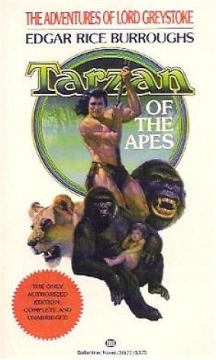
1. Barclay Shaw was commissioned by Del-Rey to paint covers for the first six Tarzan books.
This “Apes” cover was published on a 1990 paperback.
2. Charles Ren painted a tie-in cover for a Ballantine paperback which came out in 1983
to tie in with the movie, “Greystoke: The Legend of Tarzan, Lord of the Apes.”
TARZAN OF THE APES, CHAPTER XXI: THE VILLAGE OF TORTURE
This is a rather simple chapter to summarize: French officer D'Arnot leads crewmen on a jungle hunt for Jane; D'Arnot is captured by cannibals and dragged off to their village to be eaten; Tarzan shows up in the nick of time and rescues D'Arnot.It's an important chapter, because it is the first meeting between Tarzan and D'Arnot—who will play such an important role in helping the ape-man take those key steps to his full self-realization and a working knowledge of the world that surrounds his simple jungle home.
The reader, and Jane's castaway companions, met D'Arnot and other Frenchmen from the rescue ship two chapters ago, but Tarzan, as yet, knows nothing of the connection Mbonga's captive has with his other newfound white "persons of interest."
As he returns Jane to her cabin, they hear gunshots. Mr. Philander and Esmeralda are in view, so Tarzan likely assumes that it is Clayton and Professor Porter who are in need of rescuing. And so, he races toward Mbonga's village, which is the most likely spot to find someone who he can rescue before it is too late.
ERB doesn't explain what Tarzan may have thought when he saw that the captive was neither the professor nor the younger man, but Tarzan, by this time, has developed a kinship for any of his race, and that is sufficient reason for rescuing this obviously brave man from the savagery of the natives.
Then, too, he has often observed the cruelty the cannibal tribe imposes on its helpless victims, and he is ever eager to punish the tribe with his own brand of retribution and terror.
But ERB is not entirely condemning of the African savages. He provides an explanation, if not a justification, for their eagerness to torture and kill anyone of the white race. He writes: "To add to the fiendishness of their cruel savagery was the poignant memory of still crueler barbarities practiced upon them and theirs by the white officers of that arch hypocrite, Leopold II of Belgium, because of whose atrocities they had fled the Congo Free State—a pitiful remnant of what once had been a mighty tribe."
According to Wikipedia, Leopold II began laying the diplomatic, military, and economic groundwork for his control of the Congo in 1877, and ruled it outright from early 1885 until its annexation by Belgium in 1908.
“Under Leopold II's administration, the Congo Free State was subject to a terror regime, including atrocities such as mass killings and maimings which were used to subjugate the indigenous tribes of the Congo region and to procure slave labour. Estimates of the death toll range, depending on the source.”
Beginning in 1900, news of the conditions in the Congo Free State began to be exposed in European and U.S. press. By 1908 public pressure and diplomatic maneuvers led to the end of Leopold II's rule.
Since Tarzan's parents sailed from England in 1888, and he was born shortly after they were stranded by the mutineers, he would have been 18 in about 1906. That was the year that Mbonga's tribe first showed up in Tarzan's neighborhood, fleeing what was described in Chapter 9 as an unknown enemy. This chapter identifies that enemy.
- - - - - SPECIAL PASSAGE:
"D'Arnot saw a clean-limbed young giant emerge from the shadows into the firelight and come quickly toward him....Without a word Tarzan of the Apes cut the bonds which held the Frenchman.".
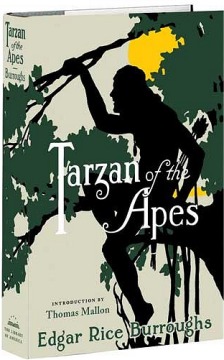
1. In 1998, the First Edition Library published a facsimilie of the first A.C. McClurg & Co. edition and added a slipcase with the dust jacket edition.
2. The Library of America published an edition of “Apes” in the style of the first edition, this featuring an introduction by Thomas Mallon
Edgar Rice Burroughs' TARZAN OF THE APES
Summary and Comments by John Martin
| ERBzine
7001
Chapters 1-7 |
ERBzine
7002
Chapters 8-14 |
ERBzine
7003
Chapters 15-21 |
ERBzine
7004
Chapters 22-28 |
TARZAN OF THE APES REFERENCES IN ERBzine
Tarzan of the Apes: C.H.A.S.E.R. Biblio Entry
www.erbzine.com/mag4/0483.html
Tarzan of the Apes: Read the e-Text Edition (28 Chapters)
http://www.erbzine.com/craft/t1ta.html

BILL
HILLMAN
Visit
our thousands of other sites at:
BILL
AND SUE-ON HILLMAN ECLECTIC STUDIO
All
ERB Images© and Tarzan® are Copyright ERB, Inc.- All Rights Reserved.
All
Original Work © 1996-2019 by Bill Hillman and/or Contributing Authors/Owners
No
part of this web site may be reproduced without permission from the respective
owners.